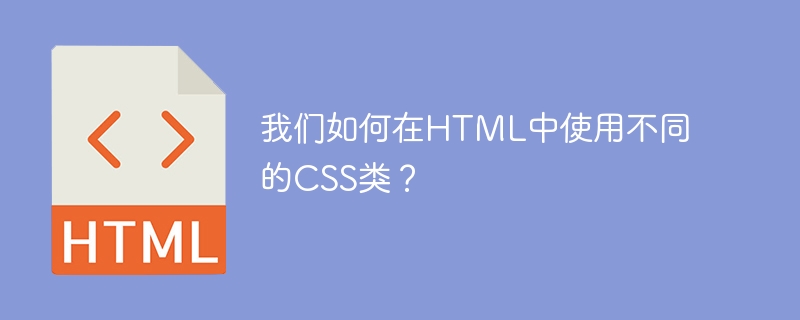我们如何在HTML中使用不同的CSS类?

我们使用class属性来为HTML元素指定一个类。
多个 HTML 元素可以共享同一个类。使用类的各种属性,例如更改颜色、字体等,我们可以为这些 HTML 元素定义样式规则。具有该类的元素将根据定义的规则进行格式化。这称为类选择器。
要选择具有特定类的元素,您需要编写一个句点(.)字符,后面跟上类的名称,例如,让我们看一下“.black”类,
.black {
color: #000000;
}
对于我们文档中class属性设置为black的每个元素,以黑色渲染内容。例如,仅对class属性设置为black的
元素以黑色渲染内容。
h3.black {
color: #000000;
}
登录后复制
h3.black {
color: #000000;
}
我们使用类属性来指向样式表中的类名。 JavaScript 还可以使用它来访问具有特定类名的元素。
示例 1
下面给出了一个示例,其中我们有两个 元素,它们的 class 属性具有相同的值。所有 元素将根据 head 标记中的样式定义进行相同的样式设置。
<!DOCTYPE html>
<html>
<head>
<meta charset="UTF-8">
<meta name="description" content="meta tag in the web document">
<meta name="keywords" content="HTML,CSS">
<meta name="author" content="lokesh">
<meta name="viewport" content="width=device-width, initial-scale=1.0">
<style>
.information,ol {
border: 2px solid black;
margin: 20px;
padding: 20px;
}
ol{
background-color: darkgoldenrod;
}
</style>
</head>
<body>
<div class="information">
<h2 id="Jason">Jason</h2>
<ol>
<li>Bachelor's of Engineering</li>
<li>IT stream</li>
<li>section -A</li>
</ol>
</div>
<div class="information">
<h2 id="Abdul">Abdul</h2>
<ol>
<li>Bachelor's of Engineering</li>
<li>IT stream</li>
<li>section -B</li>
</ol>
</div>
</body>
</html>
以下是上述示例程序的输出。
Example 2
的中文翻译为:示例2
下面给出了一个示例,其中我们有两个 元素,它们的 class 属性具有不同的值。两个 元素将根据 head 标记中的样式定义设置样式。
要定义多个类,请用空格分隔类名。元素将根据指定的类进行样式设置。
<!DOCTYPE html>
<html>
<head>
<meta charset="UTF-8">
<meta name="description" content="meta tag in the web document">
<meta name="keywords" content="HTML,CSS">
<meta name="author" content="lokesh">
<meta name="viewport" content="width=device-width, initial-scale=1.0">
<style>
.room {
font-family: monospace;
font-size: 200%;
color: tomato;
text-align: center;
}
.two{
font-family: cursive;
color: lawngreen;
text-align: center;
}
</style>
</head>
<body>
<p class="room">Meta tag contents are not visible on your browser.</p>
<p class="room two"> The mata tag is added inside the head tag.</p>
</body>
</html>
要定义多个类,请用空格分隔类名或指定不同的值。元素将根据指定的类进行样式设置。
Example 3
的中文翻译为:示例 3
给出以下示例,其中我们有三个具有不同值的class属性的元素。根据head标签中的样式定义,两个元素将被等同地进行样式设置,而另一个元素将根据head标签中的样式定义进行样式设置<!DOCTYPE html>
<html>
<head>
<meta charset="UTF-8">
<meta name="description" content="meta tag in the web document">
<meta name="keywords" content="HTML,CSS">
<meta name="author" content="lokesh">
<meta name="viewport" content="width=device-width, initial-scale=1.0">
<style>
.information,ol {
border: 2px solid black;
margin: 20px;
padding: 20px;
}
.computerscience,ul {
border: 2px solid black;
margin: 20px;
padding: 20px;
}
ol{
background-color: brown;
}
ul{
background-color: tomato;
}
</style>
</head>
<body>
<div class="information">
<h2 id="Jason">Jason</h2>
<ol>
<li>Bachelor's of Engineering</li>
<li>IT stream</li>
<li>section -A</li>
</ol>
</div>
<div class="information">
<h2 id="Abdul">Abdul</h2>
<ol>
<li>Bachelor's of Engineering</li>
<li>IT stream</li>
<li>section -B</li>
</ol>
</div>
<div class="computerscience">
<h2 id="Satya">Satya</h2>
<ul>
<li>Bachelor's of Engineering</li>
<li>Cse stream</li>
<li>section -A</li>
</ul>
</div>
</body>
</html>
以下是上述示例程序的输出。
Example 4
的中文翻译为:示例 4
另一个例子可以包括对
标签进行样式设置。通过以下方式,将所有具有class="device"的
元素进行样式设置
<!DOCTYPE html>
<html>
<head>
<style>
p.device {
background: #000000;
color: #fffffF;
}
</style>
</head>
<body>
<p>This is demo text</p>
<p class="device">Information about devices.</p>
<p>This is demo text</p>
</body>
</html>
示例 5
标签的样式可以通过多个类来完成,即此处的设备和配件 -
<!DOCTYPE html>
<html>
<head>
<style>
p.device {
background: #000000;
color: #fffffF;
}
p.accessories {
text-align: center;
}
</style>
</head>
<body>
<p class="device accessories">DEVICE DETAILS</p>
<p class="device">Information about devices.</p>
</body>
</html>
以上是我们如何在HTML中使用不同的CSS类?的详细内容。更多信息请关注PHP中文网其他相关文章!

热AI工具

Undresser.AI Undress
人工智能驱动的应用程序,用于创建逼真的裸体照片

AI Clothes Remover
用于从照片中去除衣服的在线人工智能工具。

Undress AI Tool
免费脱衣服图片

Clothoff.io
AI脱衣机

AI Hentai Generator
免费生成ai无尽的。

热门文章

热工具

记事本++7.3.1
好用且免费的代码编辑器

SublimeText3汉化版
中文版,非常好用

禅工作室 13.0.1
功能强大的PHP集成开发环境

Dreamweaver CS6
视觉化网页开发工具

SublimeText3 Mac版
神级代码编辑软件(SublimeText3)

热门话题
 &gt; gt;的目的是什么 元素?
Mar 21, 2025 pm 12:34 PM
&gt; gt;的目的是什么 元素?
Mar 21, 2025 pm 12:34 PM
本文讨论了HTML&lt; Progress&gt;元素,其目的,样式和与&lt; meter&gt;元素。主要重点是使用&lt; progress&gt;为了完成任务和LT;仪表&gt;对于stati
 &lt; datalist&gt;的目的是什么。 元素?
Mar 21, 2025 pm 12:33 PM
&lt; datalist&gt;的目的是什么。 元素?
Mar 21, 2025 pm 12:33 PM
本文讨论了html&lt; datalist&gt;元素,通过提供自动完整建议,改善用户体验并减少错误来增强表格。Character计数:159
 &lt; meter&gt;的目的是什么。 元素?
Mar 21, 2025 pm 12:35 PM
&lt; meter&gt;的目的是什么。 元素?
Mar 21, 2025 pm 12:35 PM
本文讨论了HTML&lt; meter&gt;元素,用于在一个范围内显示标量或分数值及其在Web开发中的常见应用。它区分了&lt; meter&gt;从&lt; progress&gt;和前
 如何使用HTML5表单验证属性来验证用户输入?
Mar 17, 2025 pm 12:27 PM
如何使用HTML5表单验证属性来验证用户输入?
Mar 17, 2025 pm 12:27 PM
本文讨论了使用HTML5表单验证属性,例如必需的,图案,最小,最大和长度限制,以直接在浏览器中验证用户输入。
 视口元标签是什么?为什么对响应式设计很重要?
Mar 20, 2025 pm 05:56 PM
视口元标签是什么?为什么对响应式设计很重要?
Mar 20, 2025 pm 05:56 PM
本文讨论了视口元标签,这对于移动设备上的响应式Web设计至关重要。它解释了如何正确使用确保最佳的内容缩放和用户交互,而滥用可能会导致设计和可访问性问题。
 &lt; iframe&gt;的目的是什么。 标签?使用时的安全考虑是什么?
Mar 20, 2025 pm 06:05 PM
&lt; iframe&gt;的目的是什么。 标签?使用时的安全考虑是什么?
Mar 20, 2025 pm 06:05 PM
本文讨论了&lt; iframe&gt;将外部内容嵌入网页,其常见用途,安全风险以及诸如对象标签和API等替代方案的目的。
 Gitee Pages静态网站部署失败:单个文件404错误如何排查和解决?
Apr 04, 2025 pm 11:54 PM
Gitee Pages静态网站部署失败:单个文件404错误如何排查和解决?
Apr 04, 2025 pm 11:54 PM
GiteePages静态网站部署失败:404错误排查与解决在使用Gitee...







